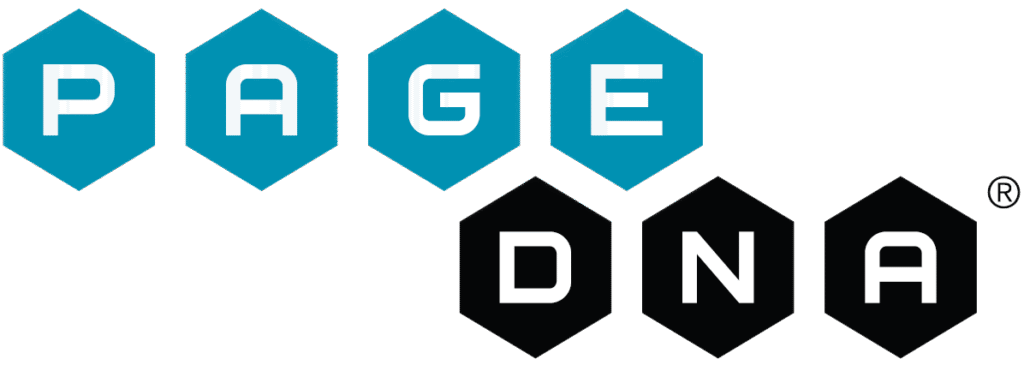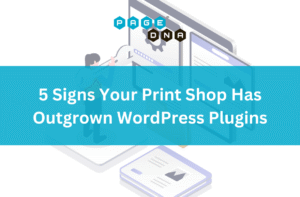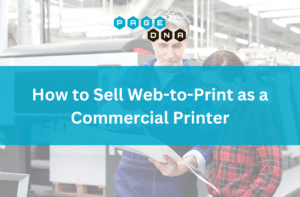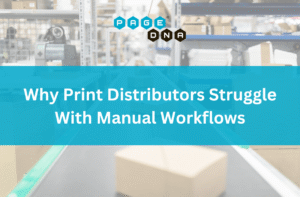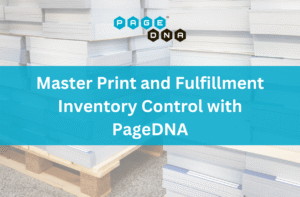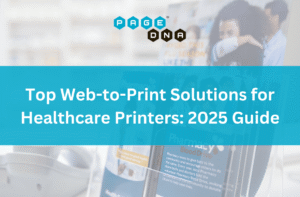What Is Outsourced Fulfillment? (B2B & Print-Focused Definition)
Outsourced fulfillment means handing off storage, pick/pack, shipping, and even print production to an external provider. Instead of owning warehouse space, managing shipping integrations, or maintaining staff, you tap into an expert ecosystem.
- Scope includes inventory storage, packaging, carrier selection, and returns.
- Industry differences: E-commerce fulfillment focuses on product orders, while B2B & print fulfillment deals with variable data printing, kitting, direct mail, and brand-safe packaging.
Relevance for B2B & Print
For print shops, marketing departments, in-plant operations, and enterprise teams, outsourced fulfillment frees up capital, accelerates turnaround, and improves campaign efficiency. Coupled with automation and SaaS—including web-to-print, MIS, ERP, CRM, and fulfillment systems—it becomes a strategic advantage
Types of Outsourced Fulfillment: Beyond E-commerce
Fulfillment Models
- 3PL (third-party logistics): Warehousing, pick/pack, carrier management.
- Print-specific & hybrid: Integrated print-on-demand, variable-data feeds, mail-out campaigns, and collateral distribution.
Fulfillment Structures
- Single-channel: Print-centric systems processing a single stream of jobs.
- Multi-channel: Supports online retail, trade show drop-ships, mailings, and B2B orders through a unified platform.
- Signs it’s time: You’ve got diverse SKUs, rush campaigns, multiple regions, varied print runs—outsourcing saves headaches and supports scale.
In-House vs. Outsourced Fulfillment: Costs, Benefits & Considerations
Cost and Risk Analysis
- Hard costs: Rent, labor, shipping, tech systems.
- Soft costs: Admin, mistakes, staff training, IT upkeep.
Outsourcing offers elastic scalability so there’s no need to staff up for busy periods or spin down during quiet times.
Trade-offs and Opportunities
- Risks include losing some control, maintaining brand consistency, and tying systems together—often solved with strong APIs and SLAs.
- Upside: faster turnarounds, smoother customer experience, sharper focus on core services.
For B2B print, consider specifics like kit assembly, packaging quality, and variable data accuracy.
How to Choose an Outsourced Fulfillment Partner
Evaluation Criteria
- Tech stack: Can they integrate with your web-to-print portal (a la PageDNA), MIS, ERP, or CRM?
- Vertical experience: Look for partners familiar with branded printing, direct mail, and kitting.
- Service level: SLAs should define pick accuracy, packaging quality, shipment timing, and error resolution.
Onboarding & Support
PageDNA stands out with US-based, relationship-driven onboarding and support, refining implementation over 20+ years.
Ask potential partners:
- How do you handle data security and integration?
- What’s your weekly support model?
- Can you scale quickly for marketing campaigns?
- What APIs and real-time data tools are available?
Red flags to be aware of include vague commitments, no real-time tracking, outdated tech, or ticket-based delays.
Steps for a Successful Transition to Outsourced Fulfillment
Strategic Planning
- Stakeholder alignment: Define goals and assign responsibilities.
- Process audit: Map workflows and locate where automation helps.
- Tech assessment: Ensure integrations are seamless with your order, inventory, and print systems (e.g., PageDNA’s API-centric platform)
Implementation
- Data migration: Sync inventory and order history across platforms.
- Integrate systems: Link MIS, ERP, web-to-print, and fulfillment software.
- Training: Equip teams with dashboards, best practices, and print quality metrics.
- Performance metrics: Track pick rates, error rates, lead times, and cost per order.
Common Challenges & Solutions
- Loss of control: Address via vendor transparency and real-time shipment dashboards.
- Data disconnects: Use middleware or APIs to ensure order and inventory sync.
- Brand consistency: Set SLAs on material quality, packaging, and print audits.
- Customer experience: Ensure personalization, simple returns, and responsive support.
A Real-World Example
A mid-size print shop partnered with a SaaS-based web-to-print provider and outsourced fulfillment. They reduced lead times from five days to 48 hours, increased margins by 14%, and handled coast-to-coast distribution with zero shipping delays.
Transition Checklist: Rollout Essentials
Pre-Launch
- Define volume, SKUs, and campaign triggers
- Document integration points (e.g., ERP ↔ PageDNA ↔ Fulfillment partner)
Enablement
- Build training modules
- Pilot QA orders
- Monitor performance daily for two weeks
Post-Launch
- Conduct quarterly reviews
- Update SLAs based on lessons learned
- Scale for new products and channels
How PageDNA Supports Your Fulfillment Strategy
- Dynamic job routing: Automates job assignment and vendor feeding
- Cost controls: Tracks buy vs. sell metrics to track and maintain margins
- Vendor SLAs: Alerts for unacknowledged or late orders
- Unified interface: One portal for customers, vendors, and staff
- Speedy launch: Average implementation in 69 days, sometimes as fast as one week
- U.S.-based support: Average 1.2-hour response time, backed by print- and fulfillment-industry experience
Recap & Next Steps
Recap: Outsourced fulfillment saves costs, boosts delivery speed, and refocuses your team—especially when backed by technology like PageDNA.
Action plan:
- Audit your current fulfillment complexity.
- Shortlist 2–3 partners with print/fulfillment integration.
- Ask about APIs, SLAs, onboarding, sample quality checks, and scaling.
FAQ: Fulfillment for B2B & Print
How is print fulfillment different from e‑commerce?
It often involves variable data, branded packaging, kitting, and staged shipments per campaign.
How hard is MIS/ERP integration?
With modern web-to-print platforms, APIs and middleware enable smooth flows between order-taking and fulfillment.
What matters most in picking a partner?
Vertical experience, tech strength, SLA clarity, and hands-on onboarding support.
How do I shift my team & clients?
Run a pilot, communicate changes, train the team, and share performance dashboards.
Can partners handle custom branding, kits, or variable print?
Absolutely—print-savvy fulfillment partners support DDP, VDP, kitting, and direct mail.
